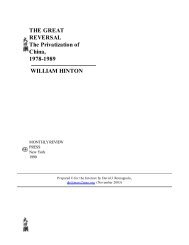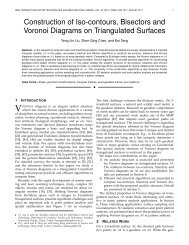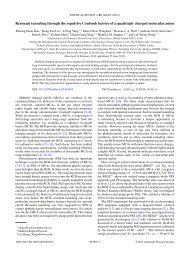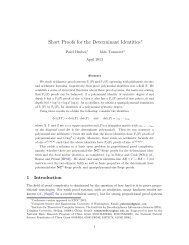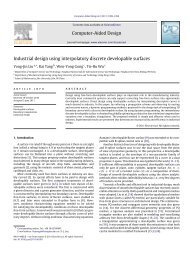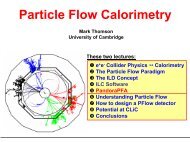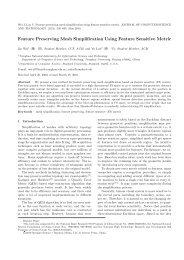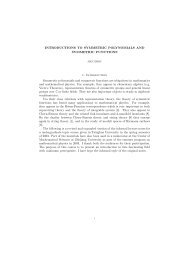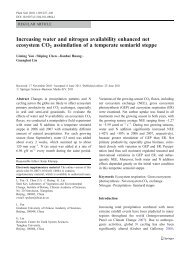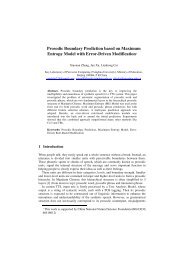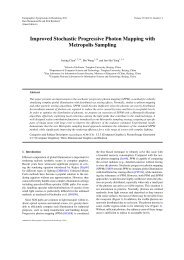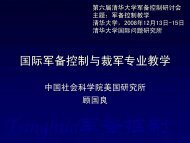Whistle: Synchronization-Free TDOA for Localization - ResearchGate
Whistle: Synchronization-Free TDOA for Localization - ResearchGate
Whistle: Synchronization-Free TDOA for Localization - ResearchGate
You also want an ePaper? Increase the reach of your titles
YUMPU automatically turns print PDFs into web optimized ePapers that Google loves.
3.4. Filtering TD2S OutliersStWe have shown a method using TD2S to calculate<strong>TDOA</strong>. But sometimes, because of the instability ofsound recording, we get wrong TD2S from defectiverecording which can be attributed to obstacles betweenS and receivers or background noises. Since when andwhere S being emitted are unknown, it is difficult togive a range which the real value of TD2S shouldlocate in. But still we can use a method to tell wrongTD2Ss from the other: majority decision.Suppose that the sound sourceM emitsS at t, whilethe base node N emits S ′ at t ′ . Receivers A and Bboth record the two signals. Thus, the TD2Ss of bothreceivers have the following relation:|∆ TD | = |T A2S −T B2S |= |((t ′ + d ANv )−(t+ d AMv ))−((t ′ + d BNv )−(t+ d BMv ))|= |(d AN −d BN )−(d AM −d BM )|v≤ |d AN −d BN |+|d AM −d BM |v≤ 2d ABv(3)Providing D is the maximum distance among allreceivers in localization (because we have positionsof N i , D can be easily got), <strong>for</strong> an arbitrary pair ofreceivers, we have |∆ TD | ≤ 2D v. So when we getcorrect TD2Ss of all receivers to <strong>for</strong>m a set D andsort it, we have TD2S max −TD2S min ≤ 2D v .If most of the TD2Ss are correct and a few havesignificant error, elements in D can be divided intothree categories: (1) a majority of elements which arein an interval whose length is shorter than 2D v ; (2) afew elements which are outside of this interval; and(3) the other elements. For arbitrary elements a in (1)and b in (2), |a−b| > 2D v .In this case we can judge category (2) as errorTD2Ss, and only use category (1) to localize S.Obviously, category (1) must have sufficient nodes tocalculate, or we have to use the whole set to get a resultwhich usually has large errors. This kind of divisionbases on the assumption that most of the TD2Ss arecorrect. Such a method works well in practice.Obviously, this method needs redundant nodes.More nodes bring extra localization or measuring cost,but enlarge the set of category (1) and enhance theaccuracy of localization. In fact, there is a trade-offbetween cost and per<strong>for</strong>mance. We empirically findt 0t1t 2t 3t 4N 0 t ′ 1 N 1 t ′ 2 N 2 t ′ 3 N 3 t ′ 4 N 4t ′ 0 t ′Figure 6: An illustration of the emissions and receptionsof both source sound signal S and system soundsignal S ′ . N 0 is the base node.that 2 ∼ 3 redundant nodes can increase locationaccuracy significantly.3.5. Framework DesignAfter discussing the details of <strong>Whistle</strong>, we presentthe <strong>Whistle</strong> framework design in this section. Asmentioned in Section 2.1, we need M(M ≥ 5) nodes<strong>for</strong> 3D localization. Without loss of generality, let N 0be the base node and N i (1 ≤ i ≤ M −1) be a nonbasenode (N 0 is not always the nearest to S). <strong>Whistle</strong>has three steps:In step one, nodes start recording, and receive Sby their own microphones. As illustrated in Fig. 6,the signal S is emitted at time t, which will arrive atN 0 , N 1 , . . . , and N M−1 at time t 0 , t 1 ,. . . and t M−1 ,respectively. Note that the time point t or t i (0 ≤ i ≤M−1) in Fig. 6 is regarding to the absolute time line,instead of the time line maintained by any individualnode N i (0 ≤ i ≤ M −1).In step two, the base node N 0 will emit a systemsound signal S ′ at time t ′ (as shown in Fig. 6) after itdetects S. The signal S ′ , of course, will arrive at eachnode after some latency. A node N i (0 ≤ i ≤ M −1)records the time t ′ i of S′ arriving at N i . Every nodemaintains a recording R i which includes both S andS ′ . Correlating R i with the reference signal, using themethod mentioned in Section 3.3, we have t ′ i − t i.For node N i , the TD2S value (t ′ i −t i) depends onlyon N i ’s own clock, provided that the clock of N i isaccurate in a term longer than the period of the soundoccurrence.In the last step, the value of TD2S will be deliveredto a node or an AP <strong>for</strong> deriving accurate <strong>TDOA</strong>values, based on which the location of the sound sourcecan be finally determined.



